VMF-512 was one of 2 USMC squadrons assigned to the USS Gilbert Islands, CVE-107. However before sailing off to the Pacific Theater the squadron had
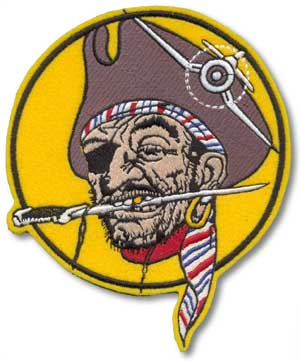 another assignment and at one point was on its way to Europe! The summary I've written here leans on several sources: Robert Sherrod's epic History of Marine Corps Aviation in World War II, Corsairs and Flattops (Marine Carrier Air Warfare, 1944-1945) by John Condon, United States Marine Corps Air Stations of World War II by M. L. Shettle, Jr., Action Reports of the USS Gilbert Islands (US National Archives via Marilynn Wright), notes of Lt. Robert Cox (via Carol Cox Liebmann) and private communications from several 512 veterans. Pictures on this page are thumbnails... click on one to see the image at full size.
another assignment and at one point was on its way to Europe! The summary I've written here leans on several sources: Robert Sherrod's epic History of Marine Corps Aviation in World War II, Corsairs and Flattops (Marine Carrier Air Warfare, 1944-1945) by John Condon, United States Marine Corps Air Stations of World War II by M. L. Shettle, Jr., Action Reports of the USS Gilbert Islands (US National Archives via Marilynn Wright), notes of Lt. Robert Cox (via Carol Cox Liebmann) and private communications from several 512 veterans. Pictures on this page are thumbnails... click on one to see the image at full size.
VMF-512 was initially formed in February 1944 as part of Marine Aircraft Group 51 (MAG-51). The first CO was Maj. Edward Finn but on March 17, 1944 Maj. Blaine Baesler took command, a position he held until the end of the war. MAG-51 was formed January 1, 1944 and shortly thereafter the 4 fighter squadrons VMF-511, 512, 513 and 514 were commissioned. After a few months MAG-51 was augmented by VMO-351, another fighter squadron recently converted from observation duties (it retained the VMO designation for a while). These 5 squadrons were part of a larger scheme to attack the German V-1 sites in Europe, Operation Crossbow. The USMC contribution was called 'Project Danny'.
VMF-512 was equipped with Corsairs and first based at the Marine Corps Auxiliary Air Facility (MCAAF) in Oak Grove NC, a newer outlying field of the larger air station at Cherry Point NC. The base was also known as New Bern, but the pilots referred to it as Pollocksville so that's what it will be called here. The 40 or so pilots were a mix of newly commissioned 2nd lieutenants and veterans who had seen action in various campaigns in the Pacific. For example Tom Liggett was a dive-bomber vet of the campaign on Guadalcanal. You can read more about his career on the web page Tom Liggett found elsewhere on this site. Harry Williams was also in the initial cadre. His log book entries show his first flight in 512 was Feb 22, 1944. Harry flew the F4U-1 and FG-1A, two designations for the same plane. The former was built by Vought and the latter by Goodyear.
In Europe the Germans had developed the V-1 'buzz bomb'. The V-2 rockets were not far behind. A nice summary of the V weapons and the strain it put on Allied Air Campaigns can be found at http://www.usaaf.net/ww2/preemptivedefense/pdpg4.htm The author points out that British aerial reconnaissance found the Peenemunde facility in 1943. In early 1944 V-1 launch sites were being constructed along the continental coast of the English Channel, and a V-1 offensive against England, a 'second blitz', was expected soon. The High Command, especially the British contingent, did not want to see more attacks on London and placed a high priority on the destruction of the V-1 launch sites. Thus Operation Crossbow was kicked off in late '43. The launch sites became targets for Allied bombing raids even though no V-1s were launched against England until the middle of June '44, a few days after the Normandy invasion.
The V-1 sites were small targets and it was not clear if high altitude bombing was an effective method to destroy them. Losses to bombers and crews were about 1% and some thought this was too high a price for little confirmed destruction. Effective attacks against the launch pads and concrete block houses required a hit in just the right place with a sufficient punch to knock them out. Smaller planes such as the RAF Mosquito or the B-25 and B-26 of the USAAF were judged by some to be more suitable but they too could be used elsewhere. The Marines of MAG-51 were assigned to this mission under the code name 'Project Danny'. According to Sherrod, VMF-514 training began for Project Danny on April 1, 1944. I assume 512 started about then too. It is not clear to me if MAG-51 was expressly formed for this mission or if it took it on shortly after its formation.
Throughout Project Danny VMF-512 was based at Pollocksville with short excursions to North Island (San Diego), presumably for carrier qualification, and Inyokern (now China Lake Naval Weapons Center, CA.) for rocket training. The Marines' weapon of choice for attacking the V-1 sites was the new 'Tiny Tim' aircraft rocket. It was 11 feet long, 11.75" in diameter with a 500 lb warhead. This was an entirely new development and rockets were not ready for the Marines until the summer of '44. Harry Williams tells me they went to Inyokern for the highly secret training and tried F6Fs too. At first the rockets were swung down on a wish-bone shaped yoke which proved unsatisfactory. The ultimate solution was to simply drop the rocket and ignite the motor via an electrical cable. This lanyard was adopted allowing the Tiny Tim to clear the propeller arc before firing and still retain reasonable accuracy.
In their book Carrier Air War in Original WWII Color, authors Robert Lawson and Barrett Tillman quote Adm. Thomas Moorer (later chairman of the Joint Chiefs of Staff under Nixon) who was staff in Naval Air Forces Atlantic during the war. "Our plan was to put six Marine squadrons on jeep carriers, and launch the F4Us from the North Sea to make a series of massive attacks on the Nazi targets. After all the planning was done, the training was in progress, and the logistics were in order, I was sent to Washington...to brief the highest civilian and military authorities including General George C. Marshall. ....General Marshall listened, but on hearing that US Marine aviators would make the planned attacks....said something to the effect, 'That's the end of this briefing. As long as I'm in charge of our armed forces, there will never be a Marine in Europe'. And there never was during World War II." Sherrod says material started to go to Norfolk July 11 in preparation for sailing to Europe. I believe Danny was cancelled about July 30. Tom Liggett remembers the squadron's gear was packed aboard ship in Norfolk and the men were headed there to embark for England. Abruptly, they were turned around and sent to Mojave CA.
According to Jeff Justice the pilots expected casualties to be 80% or more. The Corsair was a great plane, but the Tiny Tim was a heavy load and performance was compromised. To launch it effectively the pilot had to fly low and straight, a nice target for the German AA gunners who guarded the launch sites. And I wonder what effort the Germans would have made to attack US carriers in the North Sea? If one were to be sunk it would probably be a great propaganda coup. The men of 512 felt some measure of relief that this assignment was scrubbed.
Meanwhile in the Pacific, in late July 1944, Gen. A.A. Vandegrift, the Commandant of the Marine Corps, met with Adm. Chester Nimitz over a subject of special interest to the Marine Corps, namely, the conviction that Marine air forces should support Marines on the ground. The Marines wanted close air support units on carriers. Adm. Nimitz agreed and some of the new Commencement Bay class of escort carriers (CVEs) were allocated to the task. Each all-Marine CVE was to have a 12 plane TBM squadron and an 18 plane F4U fighter squadron. The MAG-51 Marines were reassigned to this mission.
In September '44 VMF-512 and MAG-51 group headquarters moved to Mojave California which became the Marines center for F4U carrier training. In October 1944 it was designated as a carrier squadron and the squadron designation was modified to VMF(CVS) to denote they were specially trained for carrier duty and close air support. (Similarly, VMTB-143 became VMTB(CVS)-143.) The designation was changed back to just VMF-512 on May 26, 1945. By the end of the war there were 4 all-Marine escort carriers: USS Block Island CVE-106, USS Gilbert Islands CVE-107, USS Cape Gloucester CVE-109 and USS Vella Gulf CVE-111. All 4 of their fighter squadrons came from MAG-51.
Training at Mojave continued throughout the fall and winter of 1944. The weather was excellent and the men became proficient in using the 5" 'Holy Moses' aircraft rockets and flying low-level attack profiles. Between the 5th and 9th of December 1944 all pilots made carrier qualification landings on the USS Ranger near San Diego.
Eventually VMF-512 and VMTB-143 were selected for deployment on the USS Gilbert Islands and VMF-512 was sent to Santa Barbara in December 1944. They moved into the buildings occupied by VMTB-143 thereby placing together the squadrons which had been assigned to the tactical unit MCVG-2 which would operate on one carrier. The escort carrier squadrons were organized into new units called Marine Carrier Air Groups (MCVG). The one on the USS Gilbert Islands was MCVG-2, Col William Campbell commanding. The 4 carrier Air Groups reported into Marine Air Support Group (MASG) 48.
At some point 512 picked up 2 F6Fs equipped for attack and photo reconnaissance. The type of planes are found in a ship's summary written by its navigator, Lt. Ray Vandervoort, USNR. He states VMF-512 had 13 FG-1D, 5 F4U-1D and 2 F6F-5P Hellcats for photo reconnaissance. The total is 20 planes, not the standard CVE complement of 18. I'm not sure of the exact date the Hellcats were assigned to 512 but it was probably after Sept '44 since the F6F pilots are not listed on the roster then. Also the vets remember it was close to the carrier's April '45 departure.
The skill of the pilots must have been quite good because flying the Corsair from a small carrier was a demanding job. The Navy tried the Corsair for their big fleet carriers and selected instead the F6F as its standard carrier-based fighter. The flight decks of the CVEs were shorter and narrower than those of the fleet carriers. As Shettle put it "Landing a Corsair on an escort carrier was not for the novice". The CVEs were slower, too, generating less wind over the deck. To overcome this CVEs were equipped with 2 catapults and most if not all launches were catapult-assisted.
 The Gilbert Islands sailed off to the war zone on April 12, 1945. To view a detailed account of the 1945 cruise of the U.S.S. Gilbert Islands please click on this map.
The Gilbert Islands sailed off to the war zone on April 12, 1945. To view a detailed account of the 1945 cruise of the U.S.S. Gilbert Islands please click on this map.
The carrier arrived off Okinawa in May.  The first wartime mission was Combat Air Patrol on May 21. Shortly thereafter the squadron suffered its first casualty when on May 23 2nd Lt. Edgar Thomas Miller crashed into the sea in his F4U-1D (BuNo 57821).
The first wartime mission was Combat Air Patrol on May 21. Shortly thereafter the squadron suffered its first casualty when on May 23 2nd Lt. Edgar Thomas Miller crashed into the sea in his F4U-1D (BuNo 57821). 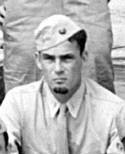 Maj. Baesler's note in the Muster Roll for May states "Died at 0733 as a result of an airplane crash at sea, latitude 25* 05' N, Longitude 127* 32' E on 23May45; Died in line of duty: not the result of own misconduct; body not recovered." The Aircraft Action report gives a slightly longer account: "At 0730, 23 May 1945, plane piloted by 2nd Lt. Edgar Thomas Miller USMC, in position 25-0N, 127-32E, crashed into sea, shortly after takeoff with three other Corsairs departing on LCAP. Cause of accident believed to be due to spin resulting from loss of air speed while attempting a tight flipper turn at low altitude." Lt. Miller was the first of 3 VMF-512 pilots to lose his life.
Maj. Baesler's note in the Muster Roll for May states "Died at 0733 as a result of an airplane crash at sea, latitude 25* 05' N, Longitude 127* 32' E on 23May45; Died in line of duty: not the result of own misconduct; body not recovered." The Aircraft Action report gives a slightly longer account: "At 0730, 23 May 1945, plane piloted by 2nd Lt. Edgar Thomas Miller USMC, in position 25-0N, 127-32E, crashed into sea, shortly after takeoff with three other Corsairs departing on LCAP. Cause of accident believed to be due to spin resulting from loss of air speed while attempting a tight flipper turn at low altitude." Lt. Miller was the first of 3 VMF-512 pilots to lose his life.
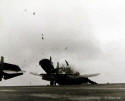 That same day one of the most amazing accidents occurred on
That same day one of the most amazing accidents occurred on
 the flight deck. In 2 stunning photographs a USN photographer captured Maj. Elton Mueller's crash as his F4U-1D skipped a wire. First we see his plane at the moment of impact with a Corsair parked at the front of the flight deck... see photo at left. Then we see Maj. Mueller's plane (BuNo 57855) going over the front of the ship with the other F4U-1D (BuNo 82842)... photo at right. Maj. Mueller was picked up unhurt! Pilot Ron Spjeldet recalls he and a mechanic were on the parked Corsair's wing checking it out. They survived by jumping into the forward safety nets.
the flight deck. In 2 stunning photographs a USN photographer captured Maj. Elton Mueller's crash as his F4U-1D skipped a wire. First we see his plane at the moment of impact with a Corsair parked at the front of the flight deck... see photo at left. Then we see Maj. Mueller's plane (BuNo 57855) going over the front of the ship with the other F4U-1D (BuNo 82842)... photo at right. Maj. Mueller was picked up unhurt! Pilot Ron Spjeldet recalls he and a mechanic were on the parked Corsair's wing checking it out. They survived by jumping into the forward safety nets.
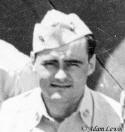 For the rest of May VMF-512 provided air cover over the task force and for the TBMs of VMTB-143 as they attacked Okinawa. On May 31 VMF-512 scored its first and only air-to-air victory of the war when Capt. Thomas Liggett, in his FG-1D (BuNo 87853) shot down a Dinah. Please visit the Tom Liggett's page for more details.
For the rest of May VMF-512 provided air cover over the task force and for the TBMs of VMTB-143 as they attacked Okinawa. On May 31 VMF-512 scored its first and only air-to-air victory of the war when Capt. Thomas Liggett, in his FG-1D (BuNo 87853) shot down a Dinah. Please visit the Tom Liggett's page for more details.
 Starting June 1 the USS Gilbert Islands was attached to a small task force with the mission to bomb and strafe the airfields on the Sakishima Islands near Formosa. The Navy wanted them to suppress the kamikazes coming from that area. The Corsairs participated heavily in the ground attack
Starting June 1 the USS Gilbert Islands was attached to a small task force with the mission to bomb and strafe the airfields on the Sakishima Islands near Formosa. The Navy wanted them to suppress the kamikazes coming from that area. The Corsairs participated heavily in the ground attack 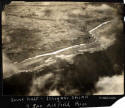 sorties typically carrying
4 Holy Moses rockets, a 500 lb bomb and a 150 gallon belly tank. The islands had a string of bluffs along the shoreline so the favorite tactic was to fly very low until the last moment, then pop up over the bluffs to attack the targets, hoping the element of surprise would work in their favor. Some of the veterans told me the AA fire was extremely intense. Condon mentions this too: "One of the surrender conditions required the Japanese to uncover all camouflage from gun positions immediately after V-J day.... the sheer number of antiaircraft weapons was unbelievable. Gun pits were tangential down the entire length of ridge lines and far exceeded what had been detected through the camouflage. ...most of the gun emplacements were not suspected." One Corsair and 2 TBMs were shot down over the islands.
sorties typically carrying
4 Holy Moses rockets, a 500 lb bomb and a 150 gallon belly tank. The islands had a string of bluffs along the shoreline so the favorite tactic was to fly very low until the last moment, then pop up over the bluffs to attack the targets, hoping the element of surprise would work in their favor. Some of the veterans told me the AA fire was extremely intense. Condon mentions this too: "One of the surrender conditions required the Japanese to uncover all camouflage from gun positions immediately after V-J day.... the sheer number of antiaircraft weapons was unbelievable. Gun pits were tangential down the entire length of ridge lines and far exceeded what had been detected through the camouflage. ...most of the gun emplacements were not suspected." One Corsair and 2 TBMs were shot down over the islands.

 On June 6 Lt. Jerome Windham ran out of fuel in his F4U-1D (BuNo 82819) and made a forced water landing. It was assumed that he had taken some hits in the belly tank which drained his fuel. Ron Spjeldet recalls Windham was in his landing approach when the engine died, and he nearly crashed into the fantail. Fortunately he was picked up unhurt and Jeff Justice and others welcomed him aboard with, it appears, an inside joke.
On June 6 Lt. Jerome Windham ran out of fuel in his F4U-1D (BuNo 82819) and made a forced water landing. It was assumed that he had taken some hits in the belly tank which drained his fuel. Ron Spjeldet recalls Windham was in his landing approach when the engine died, and he nearly crashed into the fantail. Fortunately he was picked up unhurt and Jeff Justice and others welcomed him aboard with, it appears, an inside joke.
The sorties continued and on June 8 the next  loss
loss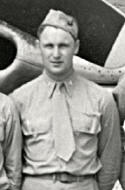 occurred when 2nd Lt. Logan Millard White, Jr was shot down in his F4U-1D (BuNo 87913) and killed. Maj. Baesler's Muster Roll entry states: "KIA at approximately 0715, 8Jun45, at Iriomote Shima, Sakishima Islands: Lat.24*20' E; Long.122*41' N; Body not recovered." The entry in the Action Report is: "At 0740, 8 June 1945, while engaged in strafing barges at Iriomote Island, the F4U-1D piloted by 2nd Lt. Logan M. White USMCR went into a violent spin and dove into the water. Small pieces of the plane were seen to fly from the plane but no AA was observed in the vicinity. The opinion that the accident was caused by enemy AA fire is unverified."
occurred when 2nd Lt. Logan Millard White, Jr was shot down in his F4U-1D (BuNo 87913) and killed. Maj. Baesler's Muster Roll entry states: "KIA at approximately 0715, 8Jun45, at Iriomote Shima, Sakishima Islands: Lat.24*20' E; Long.122*41' N; Body not recovered." The entry in the Action Report is: "At 0740, 8 June 1945, while engaged in strafing barges at Iriomote Island, the F4U-1D piloted by 2nd Lt. Logan M. White USMCR went into a violent spin and dove into the water. Small pieces of the plane were seen to fly from the plane but no AA was observed in the vicinity. The opinion that the accident was caused by enemy AA fire is unverified."
The attacks on the islands are recorded as June 2, 3, 4, 6, 8, 9, 11, 12,13, 14, 15 and 16. On the 16th a flight of 5 F4Us and 7 TBMs from the Gilbert Islands staged at Okinawa and headed off to strike the Japanese mainland on Kyushu. Due to adverse weather they were diverted to Amami O Shima where they struck the Koniya Sea Plane Base.
The Gilbert Islands was 
 ordered to proceed to Leyte on June 17.
ordered to proceed to Leyte on June 17.
 On June 18 another flight deck accident occurred when Capt. William Sharpe's Hellcat caught a wire but the tail hook came out. The F6F hit the barrier wires, flipped over and was a total loss. Fortunately Capt. Sharpe was not hurt and the deck crew got to pick up bits and pieces of the prized Plexiglas. In yet another good photo a USN photographer caught the moment. Here's the F6F (left), no tail hook, tires screeching and smoking, just as it hits the wires. At right is the aftermath. The carrier put in to Leyte on June 20. During the stop in Leyte a few photos of the squadron were taken.
On June 18 another flight deck accident occurred when Capt. William Sharpe's Hellcat caught a wire but the tail hook came out. The F6F hit the barrier wires, flipped over and was a total loss. Fortunately Capt. Sharpe was not hurt and the deck crew got to pick up bits and pieces of the prized Plexiglas. In yet another good photo a USN photographer caught the moment. Here's the F6F (left), no tail hook, tires screeching and smoking, just as it hits the wires. At right is the aftermath. The carrier put in to Leyte on June 20. During the stop in Leyte a few photos of the squadron were taken.
 Thanks to Ron Spjeldet I can show this photo of the officers with names. From the context I conclude this was taken at Leyte in June '45. Lt. Crawford (KIA July 1) is present but Lts. Miller and White are not, nor are the June 25 arrivals. Ranks were taken from the June '45 roster. Those depicted are:
Thanks to Ron Spjeldet I can show this photo of the officers with names. From the context I conclude this was taken at Leyte in June '45. Lt. Crawford (KIA July 1) is present but Lts. Miller and White are not, nor are the June 25 arrivals. Ranks were taken from the June '45 roster. Those depicted are:
|
Col. William Campbell |
Group Commander & Corsair Pilot |
|
Lt. Cmdr. William Gist, MD |
Flight Surgeon (USN) |
|
Maj. Blaine H. Baesler |
Sqn CO & Corsair pilot |
|
Maj. Elton Mueller |
Corsair pilot |
|
Capt. William D. Armstrong |
Corsair pilot |
|
Capt. Thomas Liggett Jr |
Corsair pilot |
|
Capt. John D. Noble |
Corsair pilot |
|
Capt. William Sharpe Jr |
Hellcat pilot |
|
1st Lt. Joseph C. Brinkley |
Squadron Adjutant |
|
1st Lt. Hubert H. Coyne |
Corsair pilot |
|
1st Lt. James B. Crawford |
Hellcat pilot |
|
1st Lt. Ray H. Dormandy |
Hellcat pilot |
|
1st Lt. John C. Frasher Jr |
Corsair pilot |
|
1st Lt. Lawrence E. Haynes |
Corsair pilot |
|
1st Lt. Earl W. Hopp |
Corsair pilot |
|
1st Lt. Rodney P. Johnson |
Corsair pilot |
|
1st Lt. William J. Justice |
Corsair pilot |
|
1st Lt. David Kiersey |
Corsair pilot |
|
1st Lt. Wayne A. Klever |
Corsair pilot |
|
1st Lt. Robert E. McCann |
Corsair pilot |
|
1st Lt. Jack G. Moss |
Corsair pilot |
|
1st Lt. Ray H. Schreiber |
Intelligence Officer |
|
1st Lt. Leroy A. Seipp |
Corsair pilot |
|
1st Lt. Arlo E. Southwick |
Corsair pilot |
|
1st Lt. Roland E. Spjeldet |
Corsair pilot |
|
1st Lt. Lloyd M. Steeb |
Corsair pilot |
|
1st Lt. Harry L. Williams |
Corsair pilot |
|
1st Lt. Jerome A. Windham |
Corsair pilot |
 Corsair pilot 1st Lt. Norman R. Reichwald was on the regular roster but not in this photo, so here's a picture of Lt. Reichwald.
Corsair pilot 1st Lt. Norman R. Reichwald was on the regular roster but not in this photo, so here's a picture of Lt. Reichwald.
On June 25 five pilot officers joined VMF-512. 


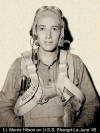 According
to Sherrod these were some of the very few Marine pilots who served
temporarily in Navy fighter squadrons aboard other carriers, in this
case CAG-99 on the USS Shangri-La (CV-38). 1st Lts. Hitson and
Januszewski were in 512 in 1944 and thus were returning to their
original unit while 2nd lieutenants Hembree, Koenig and MacKenzie were newly posted.
According
to Sherrod these were some of the very few Marine pilots who served
temporarily in Navy fighter squadrons aboard other carriers, in this
case CAG-99 on the USS Shangri-La (CV-38). 1st Lts. Hitson and
Januszewski were in 512 in 1944 and thus were returning to their
original unit while 2nd lieutenants Hembree, Koenig and MacKenzie were newly posted.
|
1st Lt. Morris W. Hitson |
Corsair pilot |
|
1st Lt. Joseph Januszewski |
Corsair pilot |
|
2nd Lt. J D Hembree |
Corsair pilot |
|
2nd Lt. Virgil V. Koenig |
Corsair pilot |
|
2nd Lt. Kenith MacKenzie |
Corsair pilot |
Thus at the end of June the pilot count was 27 Corsair (not including Col. Campbell) and 3 Hellcat pilots. The traditional complement was 50% more than the number of planes, leading to the conclusion there were 18 Corsairs and 2 Hellcats, just as stated in Lt. Vandervoort's report.
 Jeff Justice supplied the next photo. It shows the same officers as in Spjeldet's photo but also includes the sergeants in VMF-512. The 8 enlisted men are:
Jeff Justice supplied the next photo. It shows the same officers as in Spjeldet's photo but also includes the sergeants in VMF-512. The 8 enlisted men are:
|
MT/Sgt. Stanley K. Groth |
|
MT/Sgt. Joseph M. Moss |
|
MT/Sgt. William H. Nirnberger |
|
MT/Sgt. William H. Orr, Jr. |
|
MT/Sgt. Alcee Trahan |
|
T/Sgt. Robert F. Barlow |
|
T/Sgt. Edward P. Skiba |
|
S/Sgt. John W. Buchholz |
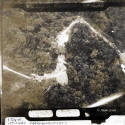 The stop at Leyte was brief as on June 26 the Gilbert Islands with the carriers USS Block Island and
Suwannee set sail for Balikpapan, Borneo. Their mission was to provide close air support to the Australians who were about to undertake the last Allied invasion of the war. Sorties began June 30. On July 1 they caught a large contingent of Japanese trucks and armored vehicles on a highway trying to escape. They were hiding under the cover at the edge of the road. The Corsairs attacked both ends of the column stopping all movement in the narrow road. The
The stop at Leyte was brief as on June 26 the Gilbert Islands with the carriers USS Block Island and
Suwannee set sail for Balikpapan, Borneo. Their mission was to provide close air support to the Australians who were about to undertake the last Allied invasion of the war. Sorties began June 30. On July 1 they caught a large contingent of Japanese trucks and armored vehicles on a highway trying to escape. They were hiding under the cover at the edge of the road. The Corsairs attacked both ends of the column stopping all movement in the narrow road. The photo-Hellcats were fully armed and participated in these missions and usually
photo-Hellcats were fully armed and participated in these missions and usually 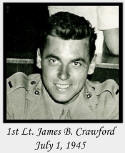 flew in last to photograph the battle damage. The F6F (BuNo 77424) piloted by 1st Lt. James B. Crawford was hit by ground fire. He was at attack level and had no chance... his plane went in and he was killed. The CO's Muster Roll entry states simply: "KIA at approximately 1230 (-9 zone) over Balikpapan, Borneo; Remains not recovered". The Action Report says: "Crawford, James Benjamin, 1st Lt. USMCR was killed while strafing the Samorinda Highway. Light caliber muzzle explosions were observed to come from camouflaged positions on either side of roadway. Plane was seen to catch fire at treetop level, continue on for 200 feet and drop in flames. Crash presumed due to AA." After the war the US government recovered his remains which were sent back to the family for burial in his home town. Rest in Peace.
flew in last to photograph the battle damage. The F6F (BuNo 77424) piloted by 1st Lt. James B. Crawford was hit by ground fire. He was at attack level and had no chance... his plane went in and he was killed. The CO's Muster Roll entry states simply: "KIA at approximately 1230 (-9 zone) over Balikpapan, Borneo; Remains not recovered". The Action Report says: "Crawford, James Benjamin, 1st Lt. USMCR was killed while strafing the Samorinda Highway. Light caliber muzzle explosions were observed to come from camouflaged positions on either side of roadway. Plane was seen to catch fire at treetop level, continue on for 200 feet and drop in flames. Crash presumed due to AA." After the war the US government recovered his remains which were sent back to the family for burial in his home town. Rest in Peace.

 Action at Borneo continued until July 3 when the carrier was ordered to return to Leyte. On the way back the Gilbert Islands crossed the equator providing the occasion for the King Neptune celebration. Here
are some antics in the VMF-512 Ready Room and Ron Spjeldet on deck. Apparently no humiliation of the pollywogs could be too great as they make the transformation to shellbacks.
Action at Borneo continued until July 3 when the carrier was ordered to return to Leyte. On the way back the Gilbert Islands crossed the equator providing the occasion for the King Neptune celebration. Here
are some antics in the VMF-512 Ready Room and Ron Spjeldet on deck. Apparently no humiliation of the pollywogs could be too great as they make the transformation to shellbacks.
Another event to note for VMF-512 occurred on July 25. The squadron was to take rocket and bomb practice in Leyte Gulf but Capt. Thomas Liggett's F4U (BuNo 87794) crashed into the sea just after launch. His escape was by the thinnest of margins... please see the web page about Tom Liggett. He was returned to the Gilbert Islands the same day however Capt. Liggett's injuries effectively ended his flying career.
The remaining days of the war were spent flying Combat Air Patrols over the fleet. Missions lasted 3-4 hours and there were no encounters with the enemy. The war ended on Aug 15 with Japan's unconditional surrender. After the war the carrier stayed in the Pacific for a few months. Both
carrier squadrons supported the "Show of Strength" over Formosa in October. Later that month the planes put in at Marpi Point, Saipan, as the carrier anchored in Saipan Harbor. Soon the journey home started and on December 6, 1945 the carrier docked in San Diego. Men with enough points mustered out and began their trips home. The squadron was disbanded in the Spring of '46.
The war ended on Aug 15 with Japan's unconditional surrender. After the war the carrier stayed in the Pacific for a few months. Both
carrier squadrons supported the "Show of Strength" over Formosa in October. Later that month the planes put in at Marpi Point, Saipan, as the carrier anchored in Saipan Harbor. Soon the journey home started and on December 6, 1945 the carrier docked in San Diego. Men with enough points mustered out and began their trips home. The squadron was disbanded in the Spring of '46.